Dec 6th 2020
How to Replace a Leaf Spring Center Bolt
How to Replace a Leaf Spring Center Bolt
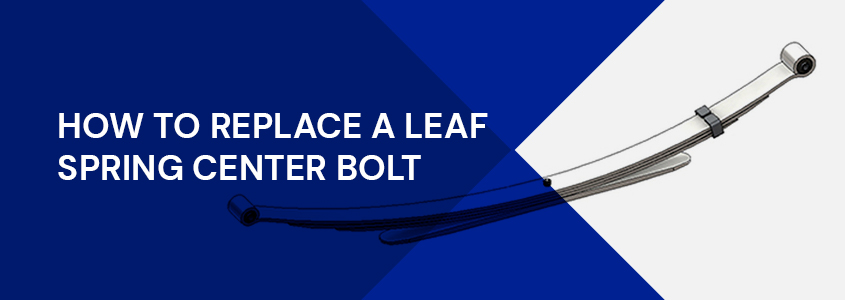
- How to Replace a Leaf Spring Center Pin
- Symptoms of a Broken Leaf Spring Center Pin
- What Happens When You Don't Replace a Broken Leaf Spring Center Bolt
In a leaf spring assembly, one of the most important pieces is the center bolt. At the center of each leaf is a hole. The bolt gets slotted through this hole in each of the four, five or more leaves that comprise a spring. Effectively, the center bolt holds the leaves together and puts them in contact with the axle. The center bolt head connects to the axle, which gives the truck its rear suspension in combination with the leaf springs.
Despite its importance, the center bolt is also one of the most potentially vulnerable parts of a leaf spring. Ensuring the center bolt does not break due to the flexing of leaves requires another component to keep the leaves bound tightly together in the form of a spring assembly. For this purpose, U-bolts bind leaf springs together.
On each side of the center bolt, U-bolts clamp the leaves into a tight spring. The center bolt relies on the U-bolts and vice versa to maintain solid leaf springs on both sides of the rear axle of a truck. Consequently, if the U-bolts are too loose, the center bolt could eventually break due to pressure from the flexing leaves.
For the U-bolts to do their job properly, the right amount of torque specs need to fasten them. This spares the leaf spring from troublesome movements that could damage the leaves, the axle and especially the center bolt.
On trucks where the U-bolts are not sufficiently fastened, the damage typically occurs in the following order — first the center bolt breaks, then the individual leaves of the spring give way more rapidly due to cracks caused by flexing motions each leaf makes against the surface of its neighbor.
Leaf spring center bolt removal can be tricky or easy, depending on the type of grip you manage to get on the pin. While it can come in handy to know how to remove the center pin from a leaf spring, you might find it best to replace the leaf spring entirely.
How to Replace a Leaf Spring Center Pin
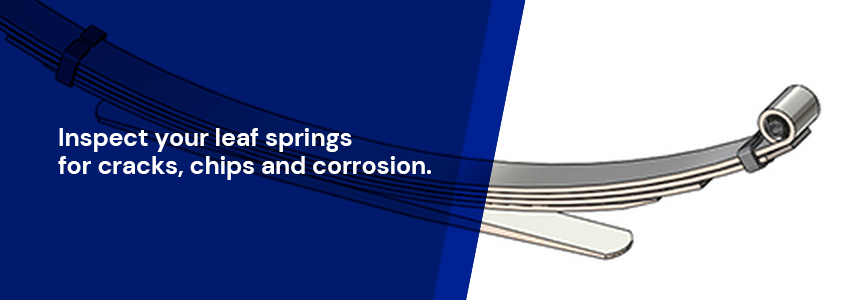
Inspect your leaf springs for cracks, chips and corrosion. Do the leaves appear worn? If not, you might just need a new center bolt. If the leaf springs got installed a short time ago or if the vehicle itself is relatively new, the problem could just come down to a weak center pin. Whether you need to change the center bolts or replace the leaf springs, you will need to access the rear suspension.
To change out a center bolt or a leaf spring, you will need the following tools:
- Floor jack
- Pliers
- Jack stand
- Pry bar
Do one spring at a time. This way, you can have a pre-installed example to use as your guide in case you get confused as you apply the first spring.
- Take the floor jack and pump the rear of the truck high enough to expose your rear-axle assembly.
- Place both jack stands under the truck on each side.
- Take out the lower bolt from the shock absorber.
- Lower the axle to remove some pressure from the leaf springs.
- Unfasten and set aside the spring-retainer bracket and U-bolts.
- Loosen the rear shackle bolt and take out the front and rear eye bolts.
- Remove the leaf spring.
If the leaves are in good condition, remove and replace the center bolt. Use vise grips on the rounded head and a socket on the other side to pull out the pin. Alternately, replace the entire leaf spring with a new center bolt. Reapply the leaf spring in the following order:
- Place the front bushing of the replacement spring into the front mounting bracket.
- Apply the front eye bolt and nut.
- Align the rear bushing and shackle of the new leaf spring.
- Install the rear eye bolt and nut.
- Raise or lower the axle to insert the center bolt of the new leaf spring into the axle pad.
- Apply the U-bolts and retainer bracket.
- Repeat these steps on the other side.
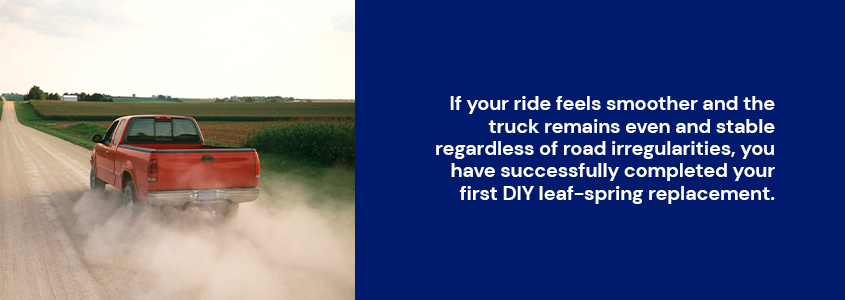
Lower the truck and take it out for a test ride. If your ride feels smoother and the truck remains even and stable regardless of road irregularities, you have successfully completed your first DIY leaf-spring replacement.
Symptoms of a Broken Leaf Spring Center Pin
If your truck has recently exhibited the following patterns while out on the road, the problem is likely rear-suspension damage rooted in the center pins. If the symptoms are mild, the issue might be isolated to one or both center bolts. If the symptoms are more severe, the problem will have likely spread to the leaves of each spring.
Tilting: If the balance of your truck feels less stable than before as you drive along uneven terrain, the suspension could be losing its ability to keep your vehicle balanced. A broken center bolt can trigger this problem because the leaves will have lost one of their key unifying pieces.
On a lot of trucks, the center bolt in one leaf spring will give out before the other, which will hasten the problem because the vehicle will lack sufficient suspension and shock absorption at one end. Consequently, the vehicle will teeter noticeably on one side, and the pressure from this imbalance will impact the other leaf spring.
Slouching: The whole purpose of leaf springs is to boost the rear suspension of your truck. Therefore, if your truck slouches at the rear, the leaf springs are not doing their job properly. As long as the spring assemblies are intact, you can rectify the problem with adjustments. If not, the leaf springs are most definitely breaking down, in which case broken center bolts would be the probable culprit.
In most cases, the problem will be most pronounced when you drive with full loads or have a trailer or boat in tow. If you even feel the truck slouch when the back is empty, inspect the issue immediately, as you probably need new leaf springs. Wait too long and your rear axle could break.
Sliding: Of all the problems broken center bolts can cause, few are as scary as vehicular rolls and slides. This can occur at intersections when the leaf springs go bad, whereby the back of the truck swerves far wider than it should as you make a left or especially a narrow right turn. In effect, the rear of the truck is almost trying to take control of the vehicle from the front tires.
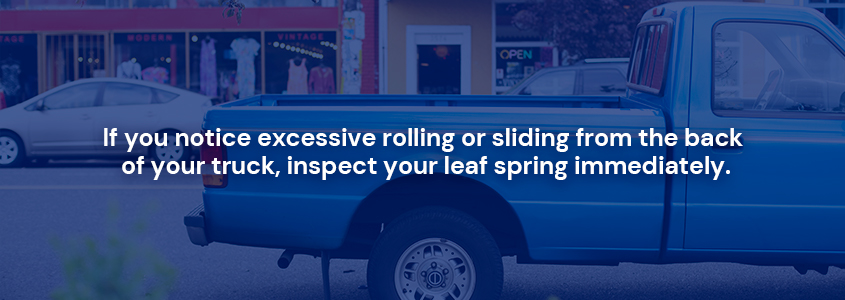
Sliding is particularly dangerous on city and suburban streets where the curbs have many obstacles such as trees, fire hydrants and newspaper stands, not to mention pedestrians. If you notice excessive rolling or sliding from the back of your truck, inspect your leaf spring immediately.
Floating: Perhaps the most frightening and dangerous symptom your truck is liable to display is floating, which occurs when your tires lose traction with the underlying terrain. Floating is typically the result of a weak rear suspension that cannot keep the axle properly aligned. This problem will generally rear its head, so to speak, when you ride a truck with broken-down leaf springs over imperfect terrain.
If you momentarily feel as if your steering has lost its bearing on the movement of your truck, the issue is likely down to a weakened rear suspension. Quite possibly, your leaf springs have given way due to broken center bolts.
Shaking: Truck driving should not be a shaky experience, regardless of the terrain. While you are liable to have ups and downs when off-roading or riding over speed bumps and potholes, the overall experience should be a smooth one, whether you drive on a freeway, cobblestone street or gravelly road. If the truck is constantly shaky as you drive, the suspension is most likely failing.
As leaf springs wear down, the cab of your truck is liable to directly absorb the shock of each major and minor imperfection along a given driving terrain. Consequently, your driving experience becomes consistently shaky and rattly. Problems like these usually begin with broken center bolts.
Worn tires: Another warning sign of a failing suspension is prematurely worn tires. If your rear tires are losing traction long before their time, chances are the excess weight on your rear axle has hastened the wearing process. If the tires appear stripped and it has only been a year since you last had them changed, inspect your leaf springs immediately.
Once the center bolts break, the leaves of each spring are liable to flex, crack and lose their suspension abilities. Consequently, the rear weight of your truck weighs down on the tires and causes the rubber to wear at an accelerated pace. If you ignore this issue, the tires could blow at the worst possible moment, such as when you are driving across a bridge or up a steep incline.
Discomfort: Last, but not least, is the most obvious symptom of all when it comes to failing rear suspension — an uncomfortable riding experience. If your trips have grown progressively less comfortable as a result of swerving, rattling, tilting, slouching and all the other effects of a truck's inability to absorb shocks properly, the leaf springs have probably worn. In all likelihood, the springs started to go bad once the center bolts broke.
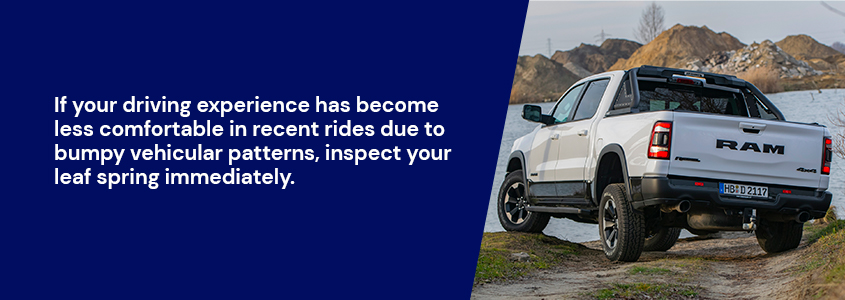
If your driving experience has become less comfortable in recent rides due to bumpy vehicular patterns, inspect your leaf spring immediately. Those tremors and shakes are warning signs of problems that are liable to become more costly, damaging and dangerous if you procrastinate on the matter.
What Happens When You Don't Replace a Broken Leaf Spring Center Bolt
A broken leaf spring center pin can lead to numerous difficulties as you drive along variable terrain. Some of the most basic functions of a given commute — from stopping at lights to handling speed bumps and sharp inclines — become more taxing on your truck and less comfortable for you as a driver when the suspension comes undone due to failing leaf springs.
Increased shock during traffic stops: Without the rear suspension of an intact pair of leaf springs, the chassis and cab of your truck are liable to bear jolts of much greater intensity at traffic lights or anytime you have to stop intermittently along a given route. When you have to drive through suburbs or along congested highways and city thoroughfares, it can make driving an uncomfortable experience.
Basically, the problems that stem from broken center bolts are not just limited to the more challenging terrain. Even when you are driving along freshly paved roads, the lack of shock absorption could turn each red light or stop/go traffic jam into a miserable experience.
Tremors along uneven terrain: Without a rear suspension system, a truck would have trouble holding up through repeated drives along gravelly terrain. With all the irregularities and bumps little rocks cause, the underside components of a truck would eventually become smashed and dented into one another due to the constant up-and-down pressure. Moreover, the rear of the truck would sink near the ground. When fully loaded, the tail bumper would possibly drag against the pavement.
Leaf springs prevent these problems from occurring, though it wouldn't be possible for a leaf spring assembly to hold itself together without the unifying piece known as the center bolt. Once these bolts break, driving tremors are liable to become progressively more intense and ultimately damaging.
Shock during speed bumps: The big irony about speed bumps is that they are a dangerous safety feature. On one hand, they are designed to keep roads, pedestrians and fellow motorists safe, but speed bumps can also be dangerous to vehicles. While a driver could damage a vehicle by constantly careening over speed bumps, a truck with poor suspension is liable to absorb undue shock even when you slow down for each bump.
If the center bolts break in your rear leaf springs, your truck could gradually begin to have problems handling speed bumps, regardless of your care as a driver. As the leaves flex and crack, each bump could inflict more and more of a jolt between the axle and chassis, and ultimately, the engine and passenger compartment.
Danger on steep hills: For your truck to keep its rear up against gravity, you need to have a solid suspension system that will carry the vehicle weight at all times, especially when you drive up steep hills. Once the center bolts break in your rear leaf springs, the gradual cracking of leaves could leave your vehicle unsupported on these challenging upward terrains. As you drive at 45-degree angles, your truck could ultimately drag against the pavement in back.
The scary thing about faulty a leaf spring is that once something as crucial as the center bolt breaks, the connecting parts give way more rapidly. A route that you were able to ride smoothly just a month or two earlier can become far more challenging and possibly damaging to your vehicle.
Inability to haul: The very nature of a truck's design places far more weight on the back of the vehicle than on the front. To keep the vehicle properly balanced, the rear suspension provides a degree of lift in back to rectify what would otherwise be a slouched tail bumper. This way, a full backload will only weigh the vehicle down to a horizontal plane, as opposed to a slouched angle.
As the center pins break and the leaf springs start to fail, however, the truck loses its ability to bear heavy loads. With failing leaf springs, a full load could cause severe slouching at the rear. In addition to making the driving experience uncomfortable, this could also smash your rear tires and cause your back tail bumper to drag.
Inability to tow: As with full backloads, towage such as boats and trailers put intense pressure on the rear end of a truck. Without a pair of intact and fully optimal leaf springs to balance weight from above and smooth out shocks from below, a truck could not bear such weight in tow.
If your truck has displayed symptoms of a broken leaf spring center pin, do not attempt to tow anything until after you inspect your springs and remedy the issue at hand.
Buy New Leaf Spring Center Bolts from General Spring
When you are out on the road, you cannot afford to have a weak pair of leaf springs. Even if the leaves are in good shape, broken center bolts will compromise the rear suspension and render your rides progressively less stable and increasingly dangerous. Before these problems spiral out of hand and affect other parts of your truck, inspect the center pins and leaves and replace them if necessary.
For new leaf springs, center pins and related parts, explore the General Spring catalog today.

